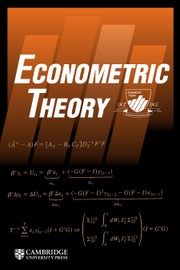Article contents
LOCAL IDENTIFICATION IN EMPIRICAL GAMES OFINCOMPLETE INFORMATION
Published online by Cambridge University Press: 17 March 2010
Abstract
This paper studies identification for a broad class ofempirical games in a general functional setting.Global identification results are known for somespecific models, e.g., in some standard auctionmodels. We use functional formulations to obtaingeneral criteria for local identification. Thesecriteria can be applied to both parametric andnonparametric models, and also to models withasymmetry among players and affiliated privateinformation. A benchmark model is developed wherethe structural parameters of interest are thedistribution of private information and anadditional dissociated parameter, such as aparameter of risk aversion. Criteria are derived forsome standard auction models, games with exogenousvariables, games with randomized strategies, such asmixed strategies, and games with strategic functionsthat cannot be derived analytically.
Information
- Type
- Research Article
- Information
- Copyright
- Copyright © Cambridge University Press 2010
Footnotes
We thank Peter Phillips for his comments, OlivierScaillet and Christian Gourieroux for theircomments on an early version of this paper, theco-editor, and two anonymous referees. Variousversions have been presented to the World Congressof the Econometric Society, Seattle, 2000, theYoung Econometricians Meeting, Marseilles, 2000,the New Zealand Econometric Study Group meeting,2006, and seminars at the University of Toulouse,2001, University of Mannheim, 2003, and Universityof Auckland, 2006.
References
REFERENCES
- 10
- Cited by

